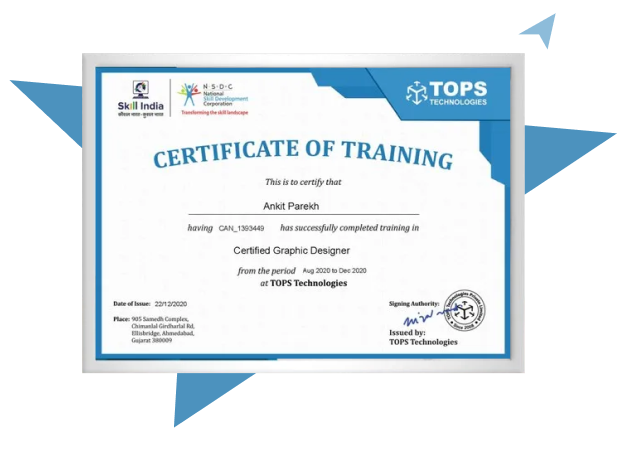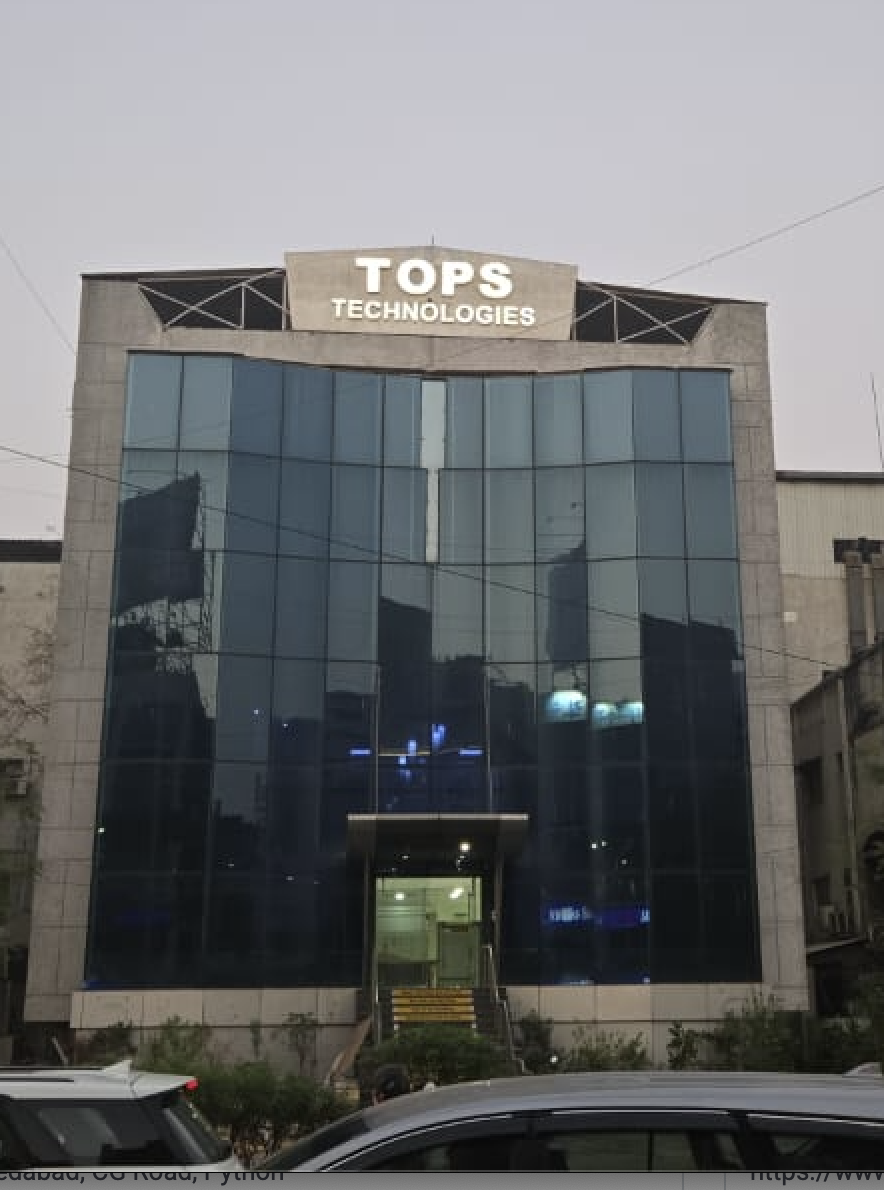Our Facts and Figures
1 Lac+
Student Placed
3000+
Companies TieUp
19+
Offices in India
50+
Industry Courses
Get 100% Job Assistance by enrolling in Certified Internet Of Things Training
Key Highlights
Limited Students Batch
Personalised Attention
Highly Qualified Teachers
Flexible Batch Timings
Interactive Learning
Live Projects
Career Support
Job Oriented Training
IOT Course Highlights
Get equipped with the IoT language at TOPS Technologies Vadodara
Quality Internet Of Things Training leading to better job opportunities for Students and Experienced Professionals TOPS Technologies, having an established IoT Training in Vadodara boosts up with highly qualified trainers and subject experts that ensure actual knowledge transfer to subject aspirants. The aim is to help IoT students carve out some remarkable job opportunities for themselves upon the completion of course.
IoT Training course in Vadodara is designed to make way for working in the live project alongside the subject experts in the Internet of things. Such opportunities for students are necessary to prepare students for their desired job. The comprehensive training programmer for IoT blends classroom sessions with senior project managers from TOPS technologies.
This creates an ideal scenario for learning as lab sessions are arranged with working experts and real-time projects. Post which, the performances are measured that helps career experts within the placement team to find the right niche for each candidate. TOPS Technologies have made a significant contribution to the lives of over 10,000 students by redefining their career path. It’s about time to join the bandwagon of success and be the master of your own future. Best decisions are taken after solving all the curiosities.
Pay a visit to the TOPS Technologies Institute Vadodara for the IOT training course and attend a risk-free demo where subject experts will address all your concerns. If you have any queries or want to join, feel free to email us at inquiry@tops-int.com.
40%
Average Salary Hike
4.5 Lacs
Highest Salary
3000+
Hiring Partners
Join Our Free Upcoming Webinar
Learn the Website Hacks and Provide Better Security
23 Dec 2025, 04:00 PM
Trainer
Faruk Pathan
(Sr. Technical Trainer)
Data Science with AI: Tools, Trends and Real-World Use Cases
24 Dec 2025, 03:00 PM
Trainer
Priya Shah
(Sr. Technical Trainer)
Learn Python in 60 Minutes
25 Dec 2025, 04:00 PM
Trainer
Sanket Chauhan
(Sr. Technical Trainer)
AI in Graphic Design – Future of Creativity
26 Dec 2025, 02:30 PM
Trainer
Parth Patel
(Sr. Technical Trainer)
IOT Course Curriculum
Download Curriculum- Introduction of IoT
- The Internet ofThings
- Introduction to Cloud Computation
- IOT Application of different domain
- Arduino Device
- Arduino IDE
- Connectivity With Serial Port
- Serial Output
- Device Connection With Arduino
- Device Controlling using Arduino Programming
- Variables
- Basic operation(add, subtract,multiply)
- Basic Variable type (string,integers)
- Concatenating String
- Booleans (True/False)
- Lists
- Lists Methods (Append, Extend)
- Adding Lists Together With +
- Sets
- FOR Loops
- Indexing
- Splitting Strings
- Tuples
- Dictionaries
- Working With Sensors
- PIR Motion sensor
- how to use Ultrasonic Sensor
- Work With DHT11 Sensor
- How to use Bluetooth Module(HC-05)
- Connect ESP8266 With Arduino For Wi-Fi Connectivity
- Connect Soil Moisture sensor With Arduino
- How Web Service Working
- Creating web service
- Fetching data in Arduino using web service
- Controlling device using web services
- MQTT
- DDS
- AMQP
- LoRa-WAN
- CoAP
- GSM
- Wi-Fi
- Establish Remote Desktop Connection
Our TOPS Training Centers in India
Course Key Features
Skills Covered
Get Training Certificate by Government
Recognized NSDC/Skill India

- National Skill Development Corporation
- Supported by the vision of PM Shri Narendra Modi
- Certification by NSDC SkillIndia
- Valid for all Jobs and College Training
- International Recognition

FAQ
IoT enables efficient management of city services such as traffic control, waste management, energy distribution, and public safety. Smart parking systems, environmental monitoring, and connected infrastructure are common examples.
IoT security is a major concern due to device vulnerabilities, weak authentication, and lack of encryption. Proper security measures like firmware updates, secure protocols, and network segmentation are necessary to mitigate risks.
Common threats include unauthorized access, data breaches, botnet attacks (e.g., Mirai), eavesdropping, physical tampering, and malware. These risks arise from poor device security and lack of standardization.
Best practices include:
- Using strong authentication
- Encrypting data
- Regular firmware updates
- Disabling unused features
- Using firewalls and secure networks
- Monitoring for unusual activity.
IoT privacy concerns how personal data collected by smart devices is used, stored, and shared. Transparency, data anonymization, and user control are critical to protecting user privacy.
Yes. If not properly secured, IoT devices can be exploited by hackers to gain control, steal data, or launch
The main components include:
- Sensors/Actuators to collect or act upon data
- Connectivity modules like Wi-Fi, Bluetooth, ZigBee
- Data Processing units (on-device or cloud)
- User Interface for user interaction
- IoT Platforms for managing devices and analyzing data.
The course covers key topics like IoT architecture, sensors and actuators, microcontrollers (Arduino, Raspberry Pi), cloud integration, MQTT protocol, real-time data processing, edge computing, and building full-fledged IoT applications.
Does the course include hands-on projects?
Yes. The IoT course is project-based and includes multiple hands-on activities, including building smart home systems, automation projects, and cloud-connected devices to give learners real-world experience.
Yes. The IoT course is project-based and includes multiple hands-on activities, including building smart home systems, automation projects, and cloud-connected devices to give learners real-world experience.
Interview Questions
IoT devices communicate by exchanging data over various communication protocols, such as MQTT, CoAP, HTTP, Bluetooth, and Zigbee. These protocols are chosen based on the application’s needs—such as power consumption, data size, and range. Devices can connect via local area networks (LAN), wireless personal area networks (WPAN), or directly to the cloud using the internet. In many cases, a central hub or gateway is used to collect, filter, and forward data between devices and cloud platforms, enabling seamless coordination and interaction among devices.
A smart city integrates IoT technologies to enhance the efficiency and quality of urban services and infrastructure. By using connected devices and real-time data, smart cities automate and optimize services like traffic management, waste collection, public transportation, and street lighting. For instance, smart traffic lights adjust signal timings based on congestion data, and smart bins notify authorities when they need to be emptied. These innovations reduce energy consumption, improve safety, and create a more livable and sustainable urban environment.
IPv6 (Internet Protocol version 6) is crucial for the expansion of IoT, as it provides a practically unlimited number of unique IP addresses—enough to assign a unique address to every IoT device globally. Beyond just scalability, IPv6 improves network performance by enabling more efficient routing and simplifies device configuration through features like auto-addressing. It also includes built-in security enhancements, making it better suited to handle the growing number of connected devices in IoT networks.
Fog computing is a decentralized computing approach that brings data processing and analysis closer to the devices that generate the data—often referred to as “the edge” of the network. Unlike cloud computing, which relies on centralized data centers, fog computing reduces the need to send data back and forth over long distances. This minimizes latency, conserves bandwidth, and ensures faster responses, which is especially important for real-time IoT applications such as industrial automation, autonomous vehicles, or emergency systems.
IoT revolutionizes business operations by enabling real-time monitoring, automation, and analytics. In manufacturing, IoT devices track machine health and production metrics, enabling predictive maintenance and reducing downtime. Retail businesses use IoT for inventory management and personalized customer experiences, while logistics firms improve fleet tracking and delivery precision. Overall, IoT empowers businesses to streamline operations, cut costs, enhance product quality, and make informed decisions based on real-time data insights.
Blockchain enhances IoT security and transparency by providing a decentralized and immutable ledger for recording transactions and data exchanges. This ensures that once data is recorded, it cannot be tampered with, which is valuable in sectors like supply chain management, where authenticity and traceability are critical. Blockchain also supports secure peer-to-peer communication between devices and can be used for managing device identities, permissions, and transactions without relying on centralized servers.
Predictive maintenance leverages IoT sensors to monitor equipment health in real-time, collecting data on parameters like vibration, temperature, and usage. This data is analyzed using machine learning algorithms to detect patterns that indicate potential failures. By identifying issues before they lead to breakdowns, organizations can schedule maintenance proactively, reduce unplanned downtime, extend equipment life, and optimize maintenance costs. It’s widely used in manufacturing, energy, aviation, and other critical industries.
Wearables are smart IoT devices designed to be worn on the body, providing real-time monitoring and feedback. Common examples include fitness trackers, smartwatches, and health monitors that track metrics like heart rate, sleep quality, physical activity, or even oxygen levels. These devices communicate with mobile apps or cloud platforms to display insights, send alerts, and help users or healthcare providers make informed decisions. Wearables are instrumental in personal health, safety, and lifestyle management.
Key components include:
- Sensors/Devices for data collection
- Connectivity Modules like Wi-Fi or Zigbee
- Processing Units such as cloud platforms
- User Interfaces like apps or dashboards for monitoring and control
Common protocols include:
- MQTT: Lightweight and ideal for IoT messaging
- CoAP: Suited for resource-constrained devices
- HTTP/HTTPS: Used for standard web-based IoT apps
- Zigbee, LoRaWAN, Z-Wave: For short/long-range wireless communication










